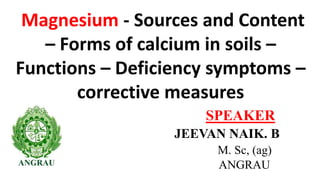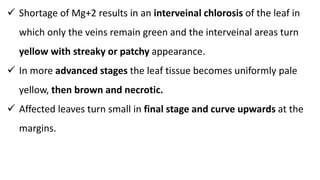Magnecium
- 1. Magnesium - Sources and Content ©C Forms of calcium in soils ©C Functions ©C Deficiency symptoms ©C corrective measures JEEVAN NAIK. B M. Sc, (ag) ANGRAU SPEAKER
- 2. Magnesium -Content ?Magnesium has a wide range of key roles in many plant functions ?One of the major well-known roles is in the photosynthesis process ?Building block of the Chlorophyll, which makes leaves appear green ?Magnesium is absorbed by plants from the soil solution as Mg+2 ?It constitutes 1.93 % of the earthĪ»s crust ranging from 0.1 % in coarse sandy soils of humid region to 4 % in fine textured soils of arid and semi arid regions.
- 3. Mg in soil originates from weathering of ? Biotite, ? Dolomite, ? Hornblende, ? Olivine, (Mg, Fe)2SiO4 ? Epsomite (MgSO4. 7 H2O) and ? Serpentine bed rock ? Also found in secondary clay minerals like chlorite, illite, montmorillonite and vermiculite; Sources of Mg
- 4. On decomposition of primary minerals, Mg is released into soil which may then be ? Lost in the percolating water ? Absorbed by living organisms ? Adsorbed by surrounding clay colloids. ? Reprecipitated as secondary mineral in arid regions. Fate of released Mg :
- 5. Forms of magnesium in soils ? In soil, magnesium is present in three fractions: ? Magnesium in soil solution -This is in equilibrium with the exchangeable magnesium and is readily available for plants. ? Exchangeable magnesium -This is the most important fraction for determining the magnesium that is available to plants. This fraction consists of the magnesium held by clay particles and organic matter. ? Non-exchangeable magnesium -Consists of the magnesium that is a constituent of primary minerals in the soil. The break down process of minerals in soils is very slow; therefore, this magnesium fraction is not available to plants.
- 7. ? Plants take up magnesium in its ionic form Mg+2, which is the form of dissolved magnesium in the soil solution. The uptake of magnesium by plants is dominated by two main processes: ? Passive uptake, driven by transpiration stream. ? Diffusion ©C magnesium ions move from zones of high concentration to zones of lower concentration. MAGNESIUM UPTAKE BY PLANTS
- 8. ?Conditions such as, low soil pH, low temperatures, dry soil conditions and high levels of competing elements, such as potassium and calcium, reduce the availability of magnesium. Under such conditions, magnesium deficiency is more likely. ?Effect of Soil pH on magnesium availability: ? Acidic soils increase the tendency of magnesium to leach, because they have less exchangeable sites (lower CEC). In low-pH soils, the solubility of magnesium decreases and it becomes less available. ?In addition, in acidic soils, elements such as Ī░Mn and AlĪ▒ become more soluble and result in reduced magnesium uptake. The availability of Mg is influenced by
- 9. ? Excessive applications of potassium and ammonium (positive-charged ions) compete with magnesium and reduce its uptake and translocation from the roots to upper plant parts. They cause Mg deficiency. ? Ca / Mg ratio Ideally it should not be greater than 7:1. ? K / Mg ratio should be less than 5:1 for field crops ? 3:1 for vegetables and sugar beet ? 2 : 1 for fruit and green house crops. ? Removal by crop : Legumes exhaust more Mg than non legumes ? Additions through fertilizers, manures and rains: FYM and oil cakes are rich source of Mg. Basic slag contains 3 ©C 4% of magnesium. Serpentines contain 26 %.
- 10. ? The concentration of Mg+2 in crops varies between 0.1 and 0.4 %. ? A large part of Mg is associated with organic anions like malate. ? Mg is the only mineral constituent of chlorophyll located at its centre. ? Serves as a structural component of ribosomes. ? Mg activates the formation of polypeptide chains to form amino acids. About 70 % of Mg is associated with anions such as malate and citrate. Functions
- 11. ? Seeds contain Mg as salt of phytic acids. Mg is required for phosphate transfer from ATP (Phosphorylation) in carbohydrate metabolism. ? Several enzymes (eg : Ribulose carboxylose) require Mg+2 as Cofactor. ? It promotes uptake and translocation of phosphorus and movement of sugars within the plants
- 12. ? Mg+2 is a mobile element and is readily translocated from older to younger plant parts hence deficiency symptoms are manifested in the older leaves. ? The Mg deficient plants usually have less than 0.1% Mg. ? Mg deficiency is common in the plants grown on coarse textured acidic soils. ? Mg+2 deficiency, the proportion of protein nitrogen decreases and that of non protein nitrogen increases in plants. Deficiency symptoms
- 13. ? Shortage of Mg+2 results in an interveinal chlorosis of the leaf in which only the veins remain green and the interveinal areas turn yellow with streaky or patchy appearance. ? In more advanced stages the leaf tissue becomes uniformly pale yellow, then brown and necrotic. ? Affected leaves turn small in final stage and curve upwards at the margins.
- 14. ? In some vegetables, interveinal chlorosis with tints of red, orange and purple colors is observed. ? Grass tetany : Cattle consuming forages with low Mg may suffer from Ī░HypomagnesemiaĪ▒ (low level of blood Mg) commonly known as Grass tetany. This happens due to high levels of NH4 + - N and K application.
- 15. ? Use of dolomitic lime stone -Ca Mg (CO3)2 ? Magnesia -Mgo 55 % (Mg) ? Basic slag -3-4 % Mg ? At a dose of 30 ©C 50 kg ha-1 Correction measures :
- 17. curve upwardsyellow, then brown and necrotic yellow with streaky or patchy
- 18. ? In more advanced stages the leaf tissue becomes uniformly pale yellow, then brown and necrotic.
- 19. Interveinal chlorosis of the leaf in which only the veins remain green and the interveinal areas turn yellow with streaky or patchy appearance
- 20. final stage and curve upwards at the margins.
- 21. Grass tetany/ Hypomagnesemia : Calcium and magnesium deficiency Occurs when cattle graze lush and immature grasses




















